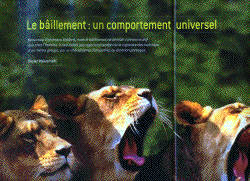- Gastroesophageal
reflux and yawning
-
- During the past
several decades, while methods to identify
nonregurgitant gastroesophageal reflux, such as
pH probe, have come into wide use, investigators
have noted some behaviors to be associated with
reflux events in infants and older individuals.
In many cases, these associations were general
rather than temporal: patients with chronic
cough, intractable hiccups, and severe stridor
had abnormal quantities of reflux, and the
behavior in question improved concurrently with
treatment of their reflux.
-
- The significant
association of discrete behaviors with onset of
reflux episodes in unselected subjects studied
prospectively supports the more anecdotal
information previously available for many of
those behaviors. The association of these
behaviors with onset of reflux is particularly
striking when one considers the low frequency of
many of the behaviors and the resultant low
power to demonstrate the association. Only three
of the behaviors (discomfort, cough-gag, and
stretch) occurred more than 20 times
during the entire study of Feranchak and
al.
-
- Three possible causal
relationships may be surmised between reflux
episodes and simultaneous discrete behaviors.
The behavior may cause the reflux, the behavior
may result from the reflux, or both may be
caused by a third event.
-
- Behaviors may cause
reflux by increasing the abdominothoracic
pressure gradient - i.e., by increasing
abdominal positive pressure (cough, sneeze,
crying) or by increasing thoracic negative
pressure (stridor, hiccups). They may also cause
reflux by inducing transient lower esophageal
sphincter relaxations, as occurs with belching
other factors which promote such relaxations are
as yet poorly defined, but might include
mouthing, thumb-sucking, yawning, or
stretching, as suggested by work
demonstrating myiohyoid activity at onset of 42%
of such sphincter relaxations.
-
- Behaviors may result
from reflux if they are manifestations of airway
soiling (cough, sneeze), of esophagitis
(discomfort), or of reflex bronchospasm,
laryngospasm, or diaphragm activity (cough,
stridor, hiccups).
-
- Behaviors may also be
caused by reflux if they are used to clear
refluxate from the esophagus (mouthing,
salivation/ drooling, and possibly
thumb-sucking, stretching, or
yawning).
-
- Yawning has not been
linked to reflux previously but was
significantly associated with onset of reflux
during the study of Feranchak et al. In each
instance, yawning followed reflux by a
few seconds and was accompanied by a rise in pH,
suggesting that yawning may aid clearance
of refluxate. Further study is needed to
determine whether the yawn modifies
gastroesophageal anatomy or pressure
relationships to assist clearance of esophageal
acid.
-
- Stretching followed
reflux in the one baby in whom it was associated
with reflux. Like yawning, which often
accompanies it, stretching may aid
refluxate clearance by modifying the
gastroesophageal junction. It may also be a
nonfunctional response to irritation due to
reflux.
- Avant que des explorations invasives
permettent d'autentifier le reflux
gastro-oesophagien, les signes cliniques
permettaient de le suspecter (toux persistante,
hoquets récurrents, stridor, etc) et de
proposer un traitement efficace les faisant
disparaitre.
-
- Bâillements
et reflux gastro-oesophagiens
-
- Avant que des
explorations invasives permettent d'authentifier
le reflux gastro-oesophagien, les signes
cliniques permettaient de le suspecter (toux
persistante, hoquets récurrents, stridor,
etc) et de proposer un traitement efficace le
faisant souvent disparaitre.
-
- Ces descriptions
cliniques ont des bases empiriques et
correspondent à des comportements rares
et inconstants. En fait trois types
d'interactions peuvent être
décrits: le comportement est la cause du
reflux, le reflux provoque le comportement, les
deux sont dûs à un troisième
évènement.
-
- Parmi les
comportements favorisant le reflux, on peut
distinguer ceux générant une
augmentation de la pression abdominale (toux,
éternuements, cris) et ceux abaissant la
pression intra-thoracique (stridor, hoquet).
Certains favorisent une relaxation du sphincter
inférieur de l'oesophage (roter, sucer le
pouce, bâiller et
s'étirer).
-
- Le reflux
déclenche lui-même des
comportements secondaires à
l'inflammation par l'acidité du
pharyngo-larynx (toux, éternuements),
à la douleur rétrosternale
ascendante, à un réflexe
(bronchospasme, laryngospasme) ou à
l'activité motrice du diaphragme (hoquet,
toux).
-
- Des comportements
peuvent aussi être liés au reflux
mais pour en contrer les effets et
évacuer le contenu refluant
(déglutition, salivation, succion,
étirements et
bâillements).
-
- Le
bâillement, bien qu'il n'ait pas
été jusqu'à présent
considéré comme un signe
associé au reflux, a été
remarqué par Feranchak et son
équipe chez un sujet sur trois de
l'étude. A chaque fois le
bâillement succède de
quelques secondes à l'épisode de
reflux. Il s'accompagne d'une ascencion du ph
suggérant que le bâillement
peut aider à évacuer le liquide
refluant. D'autres études seront
nécessaires afin de déterminer si
le bâillement agit en modifiant
l'anatomie oesophago-gastrique ou les pressions
du bas oesophage accélérant la
clairance du refluant acide.
-
- Chez un
bébé, des étirements
succédaient au reflux. Soit là
aussi, ils favorisaient une
accélération de
l'évacuation du reflux ou alors il
s'agissait d'un comportement non
spécifique extériorisant la
gêne douloureuse déclenché
par le reflux.
-
-
- Behaviors
associated with onset of gastroesophageal reflux
episodes in infants
- Prospective study using split-screen video
and pH probe
- Feranchak AP, Orenstein SR, Cohn JF.
- Clin Pediatr
(Phila)
- 1994; 33; 11;
654-662
-
- Radiopaque
contrast dye in
nasopharynx reachesthe middle
ear during
swallowing and/or
yawning
- Winther B et al
- Acta Oto-Laryngologica
- 2005; 125:
625-628
-
- The role
of the Eusatchius tube and the tympanal muscles
in yawning
- Laskiewicz A
- Revue de Laryngologie
Otologie Rhinologie
- Mai-Juin 1953 74°
année; n°5-6
-
- Yawning
with regard to the respiratory organs and the
ear
- Laskiewicz A
- Acta Oto laryngologica
(Stockholm)
- 1953; 43; 2-3;
267-270
-
- Remarques sur
la signification physiologique du
bâillement
- Lepp FH
- Bull Group Int Rech Sci
Stomtol Odontol
- 1982; 25;
251-290
-
-
-

-
- Pour La
Science
- A lire, page 66,
dans le numéro 312, d'octobre
2003
|


